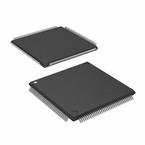●Introduction
●This data manual discusses features and specifications of the TMS320VC5407 and TMS320VC5404 (hereafter referred to as the 5407/5404 unless otherwise specified) digital signal processors (DSPs). The 5407 and 5404 are essentially the same device except for differences in their memory maps.
●This section lists the pin assignments and describes the function of each pin. This data manual also provides a detailed description section, electrical specifications, parameter measurement information, and mechanical data about the available packaging.
●Description
●The 5407/5404 are based on an advanced modified Harvard architecture that has one program memory bus and three data memory buses. These processors provide an arithmetic logic unit (ALU) with a high degree of parallelism, application-specific hardware logic, on-chip memory, and additional on-chip peripherals. The basis of the operational flexibility and speed of these DSPs is a highly specialized instruction set.
●TMS320VC5407/TMS320VC5404 Features
●• Advanced Multibus Architecture With Three Separate 16-Bit Data Memory Buses and One Program Memory Bus
●• 40-Bit Arithmetic Logic Unit (ALU) Including a 40-Bit Barrel Shifter and Two Independent 40-Bit Accumulators
●• 17- × 17-Bit Parallel Multiplier Coupled to a 40-Bit Dedicated Adder for Non-Pipelined Single-Cycle Multiply/Accumulate (MAC) Operation
●• Compare, Select, and Store Unit (CSSU) for the Add/Compare Selection of the Viterbi Operator
●• Exponent Encoder to Compute an Exponent Value of a 40-Bit Accumulator Value in a Single Cycle
●• Two Address Generators With Eight Auxiliary Registers and Two Auxiliary Register Arithmetic Units (ARAUs)
●• Data Bus With a Bus Holder Feature
●• Extended Addressing Mode for 8M × 16-Bit Maximum Addressable External Program Space
●• On-Chip ROM
● − 128K × 16-Bit (5407) Configured for Program Memory
● − 64K × 16-Bit (5404) Configured for Program Memory
●• On-Chip RAM
● − 40K x 16-Bit (5407) Composed of Five Blocks of 8K × 16-Bit On-Chip Dual-Access Program/Data RAM
● − 16K x 16-Bit (5404) Composed of Two Blocks of 8K × 16-Bit On-Chip Dual-Access Program/Data RAM
●• Enhanced External Parallel Interface (XIO2)
●• Single-Instruction-Repeat and Block-Repeat Operations for Program Code
●• Block-Memory-Move Instructions for Better Program and Data Management
●• Instructions With a 32-Bit Long Word Operand
●• Instructions With Two- or Three-Operand Reads
●• Arithmetic Instructions With Parallel Store and Parallel Load
●• Conditional Store Instructions
●• Fast Return From Interrupt
●• On-Chip Peripherals
● − Software-Programmable Wait-State Generator and Programmable Bank-Switching
● − On-Chip Programmable Phase-Locked Loop (PLL) Clock Generator With External Clock Source
● − Two 16-Bit Timers
● − Six-Channel Direct Memory Access (DMA) Controller
● − Three Multichannel Buffered Serial Ports (McBSPs)
● − 8/16-Bit Enhanced Parallel Host-Port Interface (HPI8/16)
● − Universal Asynchronous Receiver/Transmitter (UART) With Integrated Baud Rate Generator
●• Power Consumption Control With IDLE1, IDLE2, and IDLE3 Instructions With Power-Down Modes
●• CLKOUT Off Control to Disable CLKOUT
●• On-Chip Scan-Based Emulation Logic, IEEE Std 1149.1† (JTAG) Boundary Scan Logic
●• 144-Pin Ball Grid Array (BGA) (GGU Suffix)
●• 144-Pin Low-Profile Quad Flatpack (LQFP) (PGE Suffix)
●• 8.33-ns Single-Cycle Fixed-Point Instruction Execution Time (120 MIPS)
●• 3.3-V I/O Supply Voltage
●• 1.5-V Core Supply Voltage

 Part 3D Model
Part 3D Model
